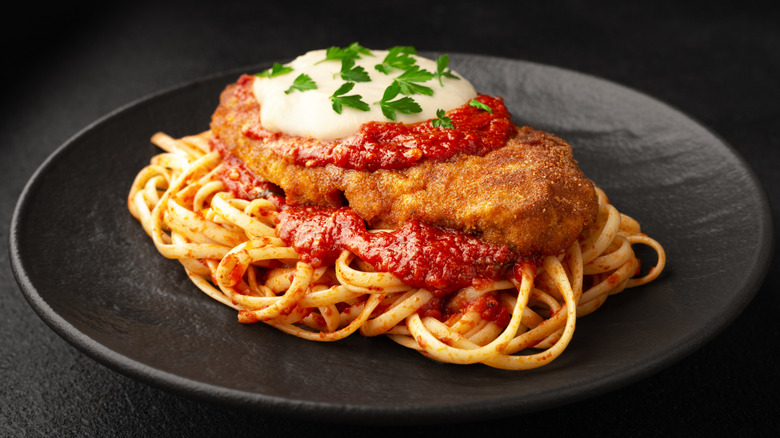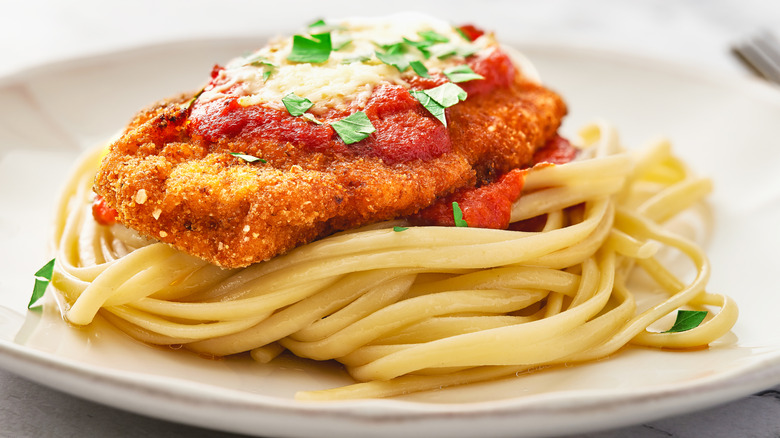The Trick For Avoiding Soggy Homemade Chicken Parmesan
It may seem shocking, but many people find great displeasure in biting into anything soggy — and, yes, I'm being extremely sarcastic. Even using the easy method of making chicken parmesan can fall flat if it's the slightest bit soggy. Overusing starchy breading and overpowering the chicken with sauce (especially one thin in consistency) are common mistakes home chefs make when cooking chicken parm.
The easiest remedy to transform your chicken parmesan from soggy to crunchy is in the breading. Rather than using purely breadcrumbs in the chicken's crust, substitute parmesan cheese for the majority of breadcrumbs. This removes a large portion of starch from the breading, making it less absorbent. One online chef recommends a parmesan-to-breadcrumb ratio of 3 to 2.
Once your breading is perfected, the next step is to guarantee the rest of your ingredients keep the crunch intact. If using a homemade pasta sauce, cook it long enough to ensure most water evaporates from it, making its consistency thicker. Only put a few tablespoons of sauce onto the chicken and serve the rest for dipping on the side. Tenderizing the chicken also maintains its integrity, allowing it to cook evenly and stay moist inside. Finally, using a stainless steel baking pan — rather than glass — is the best way to go. Stainless steel heats at a faster rate than glass, leading to a crispier chicken crust. Although the traditional form only has so many components, using different cheeses, sauces, and finishings can elevate the classic dish to a new, dazzling delight.
Elevating the traditional chicken parmesan
Chicken parmesan is a classic, Italian-American favorite, yet who's to say a timeless treasure can never be modified? One easy modification that can be made is experimenting with different cheeses. A traditional chicken parm is typically made with mozzarella and, of course, parmesan cheeses, yet many other cheeses fit the fancy.
Mozzarella and parmesan cheeses synchronize seamlessly because of their mild and sharp flavors, respectively. When pairing other cheeses together for your elevated chicken (perhaps parm-less) parm, be sure to have flavor profiles in mind. One home chef uses sweet and creamy ricotta and sharp white cheddar to do the job, proving that a large variety of cheeses can make a delicious chicken parm.
Another chicken parm elevation lies with the sauce used. Marinara is an obvious choice, but other tomato-based sauces such as arrabiata and vodka could also be delightful if balanced with the appropriate cheeses and finishings. Speaking of finishings, while basil and other herbs are commonly used, try drizzling some pesto sauce on your chicken parm. Many pesto sauces are already basil-based, yet the addition of garlic and nuts in a typical pesto adds zest to a classic chicken parm. Zest is essential in virtually all dishes, making it crucial to season during each step of your chicken parm creation. This includes seasoning the chicken, breading, flour, and even the egg wash. Trust me, your taste buds will thank you.

